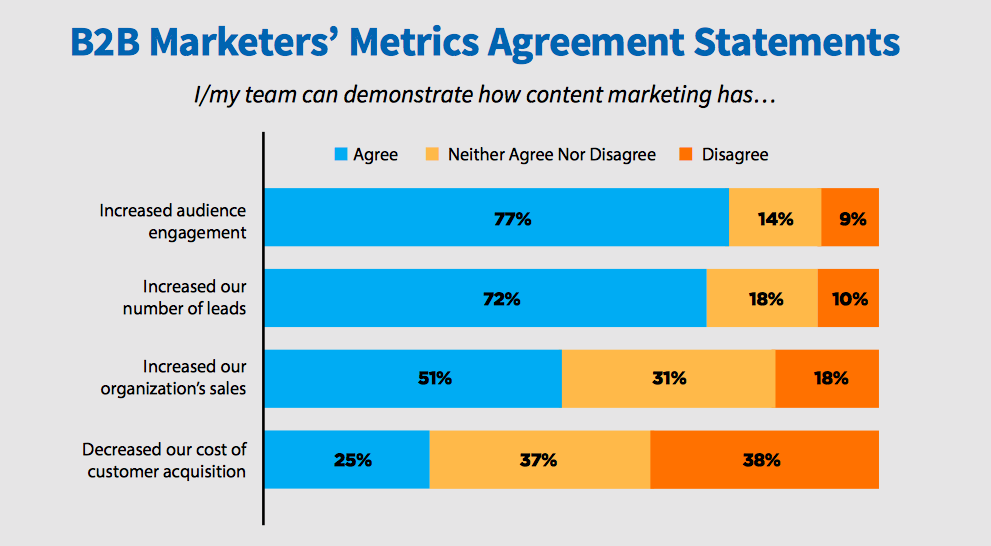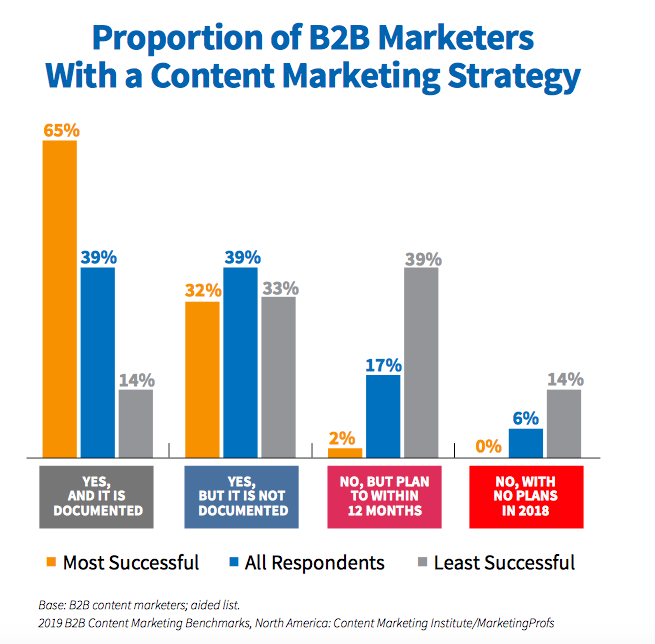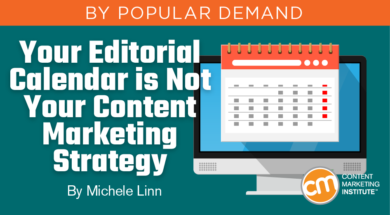As a marketer, you already know that content marketing is well worth your time and effort. What you put in is almost guaranteed to be returned to you many times over, and this attractive ROI combined with low costs and barriers to entry makes content marketing one of the most popular marketing strategies for businesses large and small.
However, it’s not always so easy to convince management and C-suite that content represents a worthy investment. Unlike traditional advertising campaigns and other types of marketing, it can be quite some time before you see the results of your content marketing campaign.
In some cases, it might take years before you build enough momentum from your content marketing activities to see real results. But only 59% of respondents surveyed by the Content Marketing Institute agreed that leadership offered enough time to demonstrate content marketing results. So how can you get executive buy-in if you’ve only got a short timeframe to prove its effectiveness?
Quick Takeaways
- Executive buy-in is important for content marketing success, but it’s not always easy to achieve.
- Backing up your case with facts, figures, and a well-considered marketing strategy is essential.
- Consider running a pilot content marketing scheme to demonstrate short-term success.
Why Getting Executive Buy-In for Content Marketing Can Be Challenging
There are actually several reasons why executives don’t immediately see content marketing as the same amazing opportunity that marketers do.
Remember, the aims of your role in the company are fundamentally different. Marketers want to raise brand visibility and generate leads, while C-suite is concerned with the overall strategic running of the business and generating income. It may not be immediately obvious how content marketing fits into this.
The main challenges or sticking points include:
- The ROI of content marketing is difficult to measure and prove.
- Results from content marketing may not be seen until months or years later.
- Producing enough content to be effective either means investing in more staff or outsourcing costs, or taking employees away from other activities.
- Content marketing is a fairly new strategy compared to more traditional marketing methods and senior level employees are therefore less likely to understand it fully and be familiar with the techniques involved.
To get executive buy-in, you need to prove the worth of content marketing in facts and figures so it’s not dismissed as just being the latest trendy tactic that doesn’t necessarily produce results.
Content Marketing By the Numbers
While you may not yet have the figures to prove the effectiveness of your own content marketing strategy, thousands of other brands and marketers have done the work for you.
Use published data and research to demonstrate how content marketing has been effective for others. Show how you will replicate this success in your own content marketing strategy.
- Consumers are 131% more likely to buy after reading educational content from a brand.
- Over 60% of adults under the age of 34 are willing to share their location for more relevant content.
- Content marketing generates 3x the leads per dollar spent when compared to paid search marketing.
- B2B companies that blog at least 11x a month have almost three times the traffic of those that blog only once a month or not at all.
- Over 80% of consumers feel more positive about a brand after reading custom content.
- 74% of companies agreed that their lead quality increased after implementing a content marketing strategy.
After presenting the generic figures and statistics, back up your research with case studies and examples from other companies and brands.
- Buffer used a content marketing strategy revolving around blogging, guest blogging, and email marketing to build their brand from scratch to a user base of 400,000, and around a million followers on social media.
- Transferwise uses a content strategy focused on creating great content, which automatically generates links and PR to generate 14 million visits a month. They published 243 articles in one year and 43% of their traffic comes from search to the high-quality content on their blog.
- Shutterstock attracted 6 billion site visits, 5,300 shares on social media, and mentions in over 100 articles from just one infographic.
- Demandbase launched a content marketing campaign including a whitepaper, infographic, webinar, and live presentation that generated 1,700 leads, 125 webinar attendees and $1million in new business.
Developing an Effective Marketing Strategy
After demonstrating the effectiveness of content marketing in general, and the success that others have seen, it’s time to set out your own strategy complete with measurable goals and a timeline for achieving them.
Your content marketing strategy is your business case for investment, so it’s vital to put work into it and build a compelling case.
65% of the most successful B2B content marketers have a documented strategy, compared to only 14% of those who are not as successful. If you don’t have a carefully considered strategy, C-suite has little reason to invest in your plans.
Your content marketing strategy should include:
- An analysis of your audience, their demographics, behaviors, and how they spend their time online (marketing personas are the most effective way to implement this.)
- Your content marketing goals and how they align with the overall business goals
- The content formats you’ll focus on such as blog posts, videos, infographics, whitepapers etc.
- The channels you’ll use for content promotion
- Your schedule for content creation and publication
- How your requested budget will be split and how you plan to stretch your budget further by repurposing content and using free and low-cost marketing techniques (include estimated cost savings).
With a detailed strategy, your proposal should be difficult to refuse. However, there is one final step to achieving total executive buy-in.
Launch a Pilot Content Marketing Plan to Demonstrate Short-Term Success
The most significant benefits of content marketing may not be seen for quite some time in the future, but you can still set achievable short-term goals to give a taster of what’s to come.
Kickstart your content marketing strategy with a pilot plan over a limited time period such as six months. Agree on a budget for your pilot, set clear goals, and make sure to measure and analyze your results regularly so you can report back to senior management.
Showing short-term gains such as an increase in website traffic or more mentions on social media can help to give your management team a preview of what may be possible over a longer timescale with more resources.















 Take a look at these two financial self-help books, for instance. Both books teach the principles of saving and investing money. But, can you guess which title sold more copies?
Take a look at these two financial self-help books, for instance. Both books teach the principles of saving and investing money. But, can you guess which title sold more copies?








